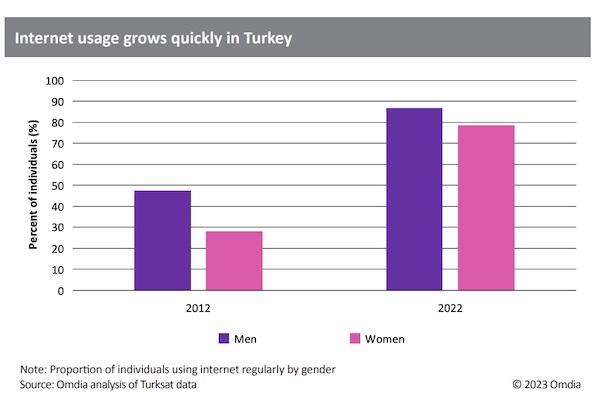
After more than 40 years of operation, DTVE is closing its doors and our website will no longer be updated daily. Thank you for all of your support.
DTVE Data Weekly: Generating subscriber growth in MENA

Source: Omdia
While in more mature markets, global streamers are emphasizing anti-churn and revenue realization as priorities over acquiring new customers, in MENA, new customer acquisition remains at least as important a priority. Omdia forecasts that by the end of 2023, just 8.8% of households in the MENA region will have an online video subscription; the use of subscription-based online video services will remain a niche pursuit in the next four years.
Despite the rapid growth of online behavior in countries such as Turkey, percolation into paid OTT remains slow. In territories where pay-TV penetration has traditionally been low, many consumers have never paid subscription fees for entertainment services. Thus, finding alternative routes and entry points for monetization will remain important.
OTT services
FAST presents one solution to the entry point problem. It allows users to watch content they might otherwise watch on a VOD service in a more familiar ecosystem through an electronic program guide and often through an application already installed on a consumer’s smart TV. The online video advertising market in MENA is forecast to reach $2.3bn by 2027, with FAST being a key component of this growth.
The announcement that TarfeehTV would become the region’s first dedicated FAST service indicates the growing potential for FAST in the MENA market, as is the focus on the FAST segment by the region’s leading streaming service, Shahid.
MENA’s e-commerce customer base is also growing on platforms such as Noon. For the 2023 Indian Premier League (IPL), Noon took its service in a new direction by providing the capacity to stream IPL on its e-commerce platform for a fee. The return on the content investment for e-commerce platforms such as Noon comes through multiple avenues: standalone subscription revenue, advertising revenue, gamification, and funneling information into e-commerce. The combination of these factors and the large e-commerce user base make the partnership a natural one, and this has been thoroughly exploited in other regions.
Finally, making more use of social media should be a natural part of the funnel for MENA platforms, as many already make use of extensive free content. One key aspect of the success of the Arab-speaking world’s largest platform, Shahid VIP, is that the transition to subscription video can be made at several entry points from a broadcaster video platform with extensive use of free episodes, while several other services use YouTube as a hook.
In developing markets, appealing to customers who are price sensitive—or just generally not in the habit of paying for entertainment—will underpin future growth. Thus, businesses that can effectively use these alternative entry points are the most likely to be successful.
Daoud Jackson, is Omdia’s Senior Analyst, TV & Online video